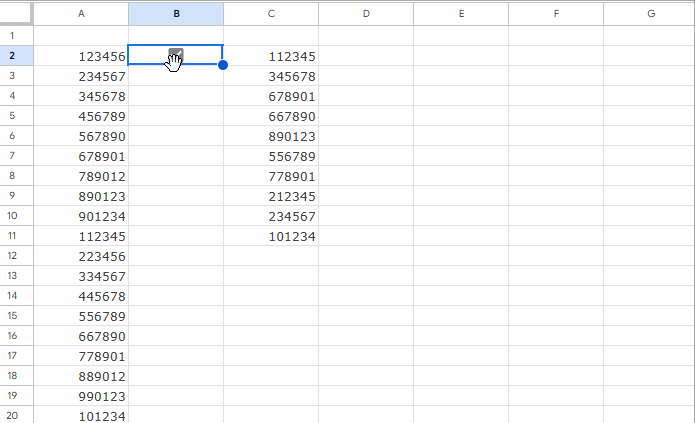This tutorial covers an efficient solution to randomly select N numbers or values in Google Sheets. The key functions used are SORTN, UNIQUE, and RANDARRAY. If the list contains duplicates, the formula will automatically select only the unique values.
Real-Life Applications
Here are some scenarios where this formula can be applied:
- Selecting a random group of players.
- Choosing N winners in a lottery.
- Excluding excess participants randomly when you have a limited quota.
Formula to Randomly Select N Numbers
=LET(
range, TOCOL(UNIQUE(cell_range), 3),
SORTN(range, n, 0, RANDARRAY(ROWS(range)), 1)
)In this formula:
- Replace cell_range with the column reference containing the values you want to randomly select.
- Replace n with the number of random values you want to pick. If the cell_range contains fewer numbers than the value specified in n, the list will be returned as is, but without duplicates.
This formula works for randomly selecting numbers, text, or any other data types.
Example: Randomly Selecting N Values
Suppose you have lottery serial numbers in the range A2:A and want to randomly pick 10 numbers without duplicates. Use the formula:
=LET(
range, TOCOL(UNIQUE(A2:A), 3),
SORTN(range, 10, 0, RANDARRAY(ROWS(range)), 1)
)
Lottery numbers often include alphanumeric characters, such as AX-125467B. Since the formula works with any data type, it will efficiently pick N winners, regardless of whether the values are numeric or text.
Anatomy of the Formula
This formula has several components. Let’s break it down step-by-step. The LET function is used to simplify the formula by assigning names to intermediate results. Its syntax is:
LET(name1, value_expression1, [name2, value_expression2, …], formula_expression)In the Formula:
- name1:
range - value_expression1:
TOCOL(UNIQUE(A2:A), 3)
What Does value_expression1 Do?
UNIQUE(A2:A): Extracts distinct values from the range. If the range contains empty cells, an empty string will appear in the result.TOCOL(..., 3): Converts the column into a single array while removing empty and error values.
This intermediate result (range) is then used in the next part of the formula.
The formula_expression Explained:
SORTN(range, 10, 0, RANDARRAY(ROWS(range)), 1)Here’s how this works:
- SORTN: Selects and sorts the top N rows.
- range: The array of unique values generated earlier.
- n:
10, the number of random values to return. - display_ties_mode:
0, ensures only the first 10 rows are returned. - sort_column:
RANDARRAY(ROWS(range)), generates random numbers for sorting. - is_ascending:
1, sorts the random numbers in ascending order.
This ensures that 10 random values are selected and sorted.
Prevent the Formula from Changing on Every Update
By default, RANDARRAY is volatile, meaning the results refresh every time you edit the sheet or at specific intervals set under File > Settings. If you want the formula to remain static until triggered, you can use the LAMBDA function.
Steps:
- Insert a tick box in an empty cell (e.g., B2) via Insert > Tick Box.
- Use this modified formula in C2:
=IF(
B2=FALSE, ,
LAMBDA(
randN, SORTN(TOCOL(UNIQUE(A2:A), 3), 10, 0, randN, 1)
) (RANDARRAY(ROWS(TOCOL(UNIQUE(A2:A), 3))))
)
Explanation:
- When B2 is unchecked (
FALSE), the formula returns an empty string. - When checked, it randomly selects N numbers/values.
- randN: A name assigned to
RANDARRAY(ROWS(TOCOL(UNIQUE(A2:A), 3)))within the LAMBDA function. - LAMBDA Syntax:
=LAMBDA([name, ...], formula_expression)(function_call, ...)Here:
- name:
randN - formula_expression:
SORTN(TOCOL(UNIQUE(A2:A), 3), 10, 0, randN, 1) - function_call:
RANDARRAY(ROWS(TOCOL(UNIQUE(A2:A), 3)))
This approach prevents the formula from recalculating unless you toggle the tick box.
Additional Resources
- Pick a Random Name from a Long List in Google Sheets
- How to Shuffle Rows Randomly in Google Sheets
- Google Sheets: Macro-Based Random Name Picker
- Randomly Extract a Percentage of Rows in Google Sheets
- Generate Odd or Even Random Numbers in Google Sheets
- Pick Random Values Based on Condition in Google Sheets
- Interactive Random Task Assigner in Google Sheets
- Generate Random Groups in Google Sheets






















Excellent article and explanation, thank you very much! But the formula came back #Error in my Spreadsheets. Do you help me with any solution?
Hi, vInsight,
Please check your LOCALE settings and change the formula accordingly.
This may help.
How to Change a Non-Regional Google Sheets Formula.
If this doesn’t come helpful, please share a sample (mockup) sheet.
Hi Prashanth! Thank you so much for this equation. I’m about 95% through my project, thanks to this. I have a question, though.
Are you able to insert a FILTER function into this equation? Say, for instance, I had a large data set to apply your equation to, but only wanted to pull random numbers that met certain conditions:
So, instead of your fixed range, (A1:A20), let’s say I wanted to do something like
FILTER(A2:A,A2:A$D3) . . . where D=100;FILTER(A2:A,A2:A>$D4) . . . where D=500, etc.So I was hoping the filter function could be integrated into your master formula:
Any suggestions?
Thanks in advance!
FILTER(A2:A,A2:A>$D3)* . . . where D=100—- editHi, Stephen,
For this, I am going to provide you a different formula. If that doesn’t help, please share an example sheet with me in reply.
Google Sheets has now a more convenient formula to generate random numbers in an array form and that is RANDARRAY. I am going to use that here in SORTN.
=SORTN(FILTER(A1:A,A1:A>D3),9^9,0,randarray(COUNTA(FILTER(A1:A,A1:A>D3)),1),TRUE)How to use this formula?
This filters the numbers in column A based on the value in cell D3 and randomizes the filtered output.
The 9^9 in the formula is to return all the filtered values in random order. You can change that to any number to limit the number of rows in the output. If you set it to 10, you will get 10 random numbers. But if the filtered output doesn’t contain 10 numbers, the formula would return an error.
To understand the formula please check the individual tutorials related to SORTN and RANDARRAY. I’ll try to write a tutorial on the combined use later.
Best,
Prashanth KV
Hi Prashanth, fantastic article and great explanation, thanks so much! It really helped me with my research.